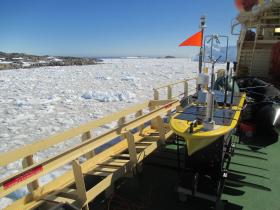The Southern Ocean is key to Earth’s climate, but the same gusting winds, big waves and strong currents that are important to ocean physics make it perilous for oceanographers.
articles
WSU researchers see popular herbicide affecting health across generations
First, the good news. Washington State University researchers have found that a rat exposed to a popular herbicide while in the womb developed no diseases and showed no apparent health effects aside from lower weight.
Ageing Star Blows Off Smoky Bubble
In the faint southern constellation of Antlia (The Air Pump) the careful observer with binoculars will spot a very red star, which varies slightly in brightness from week to week. This very unusual star is called U Antliae and new observations with the Atacama Large Millimeter/submillimeter Array (ALMA) are revealing a remarkably thin spherical shell around it.
Mathematics predicts a sixth mass extinction
In the past 540 million years, the Earth has endured five mass extinction events, each involving processes that upended the normal cycling of carbon through the atmosphere and oceans. These globally fatal perturbations in carbon each unfolded over thousands to millions of years, and are coincident with the widespread extermination of marine species around the world.
Breaking Legume's Crop Wild Relative Barrier
Domesticating plants to grow as crops can turn out to be a double-edged scythe.
NASA Gets an Infrared View of Large Tropical Storm Jose
Satellite imagery shows that Jose is a large storm, with a large reach. NASA’s Aqua satellite captured cloud top temperatures of Tropical Storm Jose that revealed the strongest storms were in the northeastern part of the tropical cyclone but the storm is so large that it is causing dangerous ocean conditions from Bermuda to the U.S. East coast.










